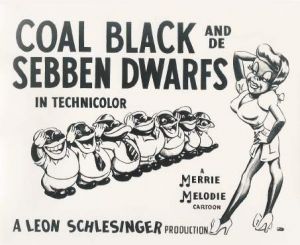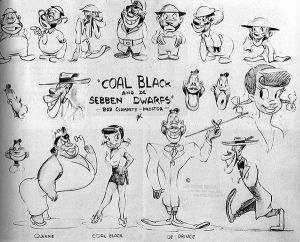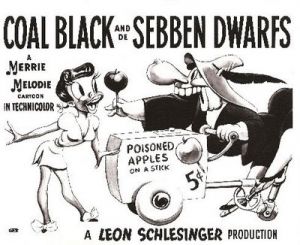Coal Black and de Sebben Dwarfs
Coal Black and de Sebben Dwarfs is a Merrie Melodies animated animation directed by Bob Clampett and produced by Leon Schlesinger Productions for Warner Bros in 1943. On January 16, 1943, the film was released.[1] The cartoon is a black-and-white spoof of the Brothers Grimm fairy tale Snow White, made famous by Walt Disney's 1937 animated film Snow White and the Seven Dwarfs. As a result, it is one of the most divisive cartoons in the Warner Brothers archive. As a result, United Artists banned the syndication of this cartoon in 1968, and following the consequence this cartoon listed into the famous Censored Eleven.
"So White And De Sebben Dwarfs" was the working title. To prevent misunderstanding with the Disney feature, it was updated at the last minute.[2]
Plot
The setting of Coal Black is modernized, as opposed to the "timeless" approach of Disney's Snow White. Coal Black, directed by Leon Schlesinger and released in 1942, is set during World War II, and the dwarfs are tiny American soldiers stationed at homefront.
The short began with the Mammy lead, who is obviously a big black woman with a distinct "Negroid" voice despite being in darkness. The Mammy is telling a story to her baby, who is a big-cheeked pickanny with a bow in her hair.
The story begins with the Queen of the palace requesting a 6-foot-tall prince to be sent to the magical mirror. The Prince named Prince Chawmin arrived in limousine. The protagonist So White sings "My hair coal black and my name So White and I washes all day" back in laundry room also looking for Prince Charming. Prince Chawmin greets So White and tells her that he is the prince she has been waiting for, and the two dance and sing happily together. Enraged and jealous The Queen attempts to eliminate So White by contacting The Murder Inc. So White was kidnapped by the Murder Inc. and dumped in the jungle. The Sebben Dwarfs, American soldiers on the homefront during World War II, are met by alive So White.
Meanwhile, the queen discovers that So White is still alive and prepares a poisoned apple to give to the girl in order to kill her. The queen disguises herself as an elderly peddler and travels to the Sebben Dwarfs' camp to deliver the poisoned apple to So White. One of the seven dwarfs informs the others that the queen is responsible for the death of So White. The dwarfs load a cannon with both a war shell and "Dopey" as the queen flees over the hills. The queen has been defeated, but White is still dead in the eyes of the world. In spoken rhyme, the dwarfs say:
She's outta this world! She's stiff as wood!
She's got it bad, and that ain't good!
There's only one thing that'll remedy this
and dat's Prince Chawmin' and his Dynamite Kiss!
The prince enters the scene in a spotlight after the dwarfs invoke his name, promising to "give her a kiss." So White did not wake up after Prince Chawmin kissed her. Prince Chawmin' kisses So White frantically in an attempt to awaken her, but to no avail. He becomes a withered old, pale-faced man, shrugging his shoulders in defeat, as his face turns blue from exhaustion. The "Dopey" dwarf then strolls over to So White and gives her a goodbye kiss to the tune of "You're in the Army Now," causing So White to wake up.
The Controversy
In April 1943, the NAACP protested the caricatures which appeared in Coal Black and de Sebben Dwarfs, and called on Warner to withdraw it.[3]
Coal Black contains the same basic stereotypical elements as the earlier Censored Eleven films, but they are depicted in greater detail and made to conform to Clampett's "wacky" directorial style. The Mammy character, who is clearly a large black woman with a distinct "Negroid" voice, is the first of many black stereotypes thrown into the mix in this short. Prince Chawmin is a similarly caricatured black man, with straightened hair, a white zoot suit and a monocle, and gold teeth (his two front teeth are dices for teeth–an homage to the long-held stereotype of African Americans as gamblers). So White is depicted as a younger black woman with big bottoms, perky bosoms, and revealing clothing. A mammy caricature is only a bandanna and slippers away for the Wicked Queen. The characters all have the stereotypical ethnic caricature of large lips and, of course, black skin.
The film's portrayals of African Americans also reflected some realities of African American life in 1942, and these images may have contributed to the film's demise in 1968. The dwarfs are an all-African American military unit that acknowledges that the United States had a segregated army at the time. So White’s job as a laundress was one of the most common occupations for African American women at the time, especially in the Jim Crow South.[4]
External Link
Watch Coal Black and de Sebben Dwarfs at Dailymotion
Coal Black and de Sebben Dwarfs at IMDb
References
- ↑ Coal Black and de Sebben Dwarfs retreived December 20, 2020
- ↑ IMDb Trivia retrieved December 20,2020
- ↑ Slotnik, Daniel E. (April 28, 2008) Cartoons of a Racist Past Lurk on YouTube Retrieved December 20, 2020
- ↑ Cartoon Research retrieved December 20,2020


